Features of the terrace of a country house
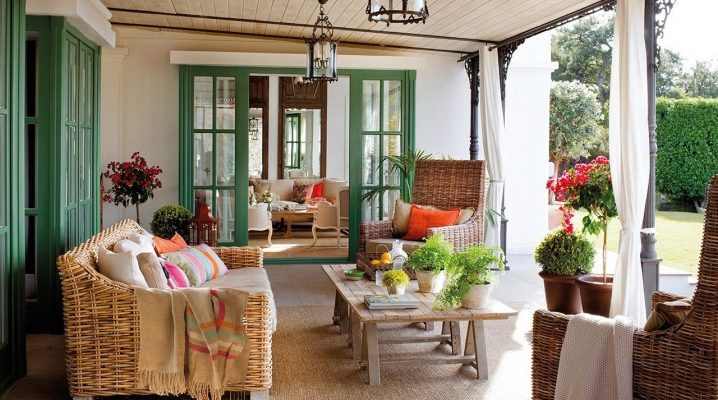
It is nice to relax under the shade of trees in the warm season, chat with friends in the fresh air, without leaving your comfort zone. Trips to the forest involve hassle, and the terrace is exactly the place that allows you to combine comfort and relaxation in nature.
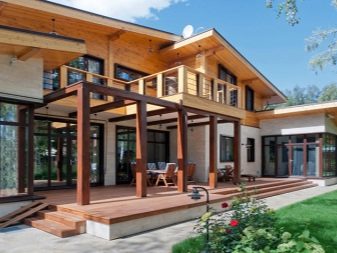
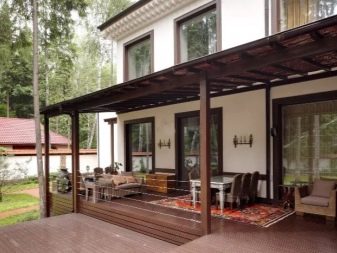
Peculiarities
A terrace should not be confused with a veranda, gazebo, porch or balcony. It can be attached to the house, like a veranda, or removed from it, like a gazebo, or located on top, hanging over the first floor, like a balcony. But it has its own characteristics.
The terrace, in contrast to the veranda, is an open area with one wall in common with the house. The annex has a roof and railings, but can be dispensed with.
The simplest version of this structure is a wooden flooring at the floor level of the first floor of the house.
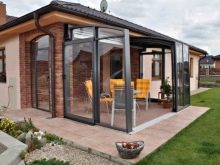
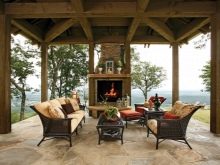
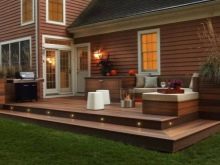
A freestanding terrace looks like a gazebo, but there are some differences: the presence of a roof and a parapet is not essential for it. The narrow balcony is attached to the house and does not have a wide seating area. As for the porch, the difference is obvious: even the smallest terrace can accommodate a couple of chairs.
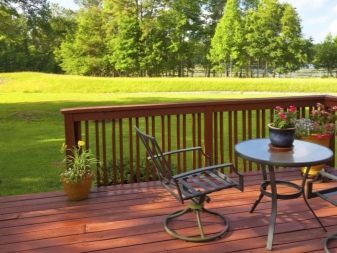
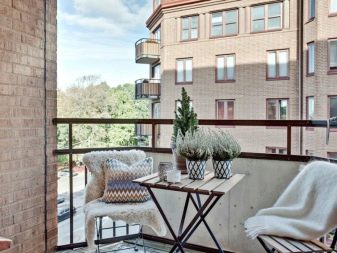
An extension is a continuation of a house standing on a common foundation., but in most cases it has a separate base. The terrace is used for both country mansions and small summer cottages. There are many options for the location of the extension, it can be in front of the building or around it, fully or partially under the roof. This building is a functional addition to the home and can become a summer dining room, living room or just a relaxation area.
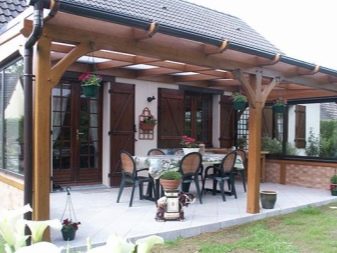
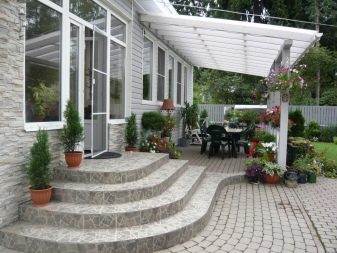
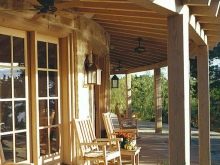
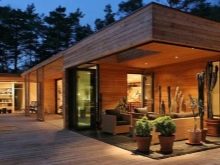

The terrace can be easily arranged in the form of a summer living room by arranging sofas, armchairs and a small table under a canopy or simply under the open sky. For such cases, special garden furniture made of rattan, vine or wood is provided.
Many people use the extension to create a summer dining room. The open air awakens appetite, and any dish seems especially tasty, moreover, a boring lunch can turn into a pleasant family interaction. To prevent meals with family or friends from being interrupted by a sudden rain, columns with a roof are installed above the flooring. This option saves not only from bad weather, but also from the summer heat.
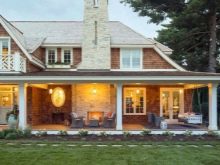
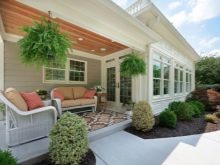
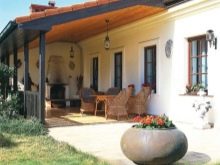
The terrace can be arranged like French summer cafes with cozy tables and chairs, vegetation in flowerpots, or you can arrange sofas and armchairs with covers and a table made of aged oak in the Provence style. Often, in addition to the dining room, a kitchen area with barbecue and barbecue is equipped on the terrace, decorating it in the same vein as the dining area. The presence of live fire and delicious food turns simple communication into a real holiday. Under a canopy, even rain will not interfere with the preparation of barbecue.
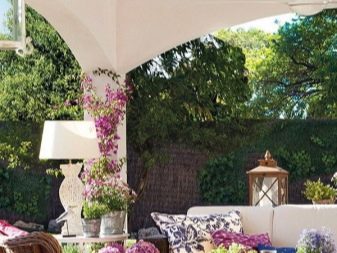
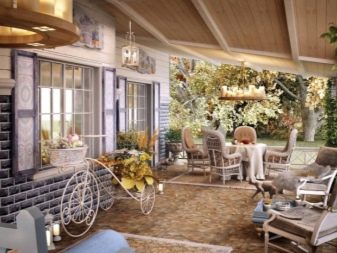

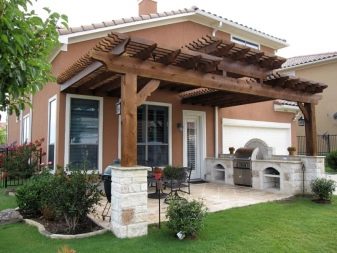
The flooring near the house is used for a comfortable platform with a swing. If you can call it a swing, benches, armchairs, sofas and beds suspended from the ceiling beams. All this furniture is covered with covers and equipped with soft pillows. Even a short rest in the fresh air stimulates a surge of energy and an influx of vitality.
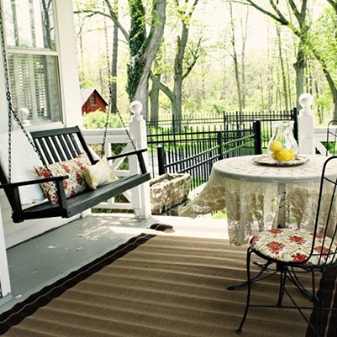
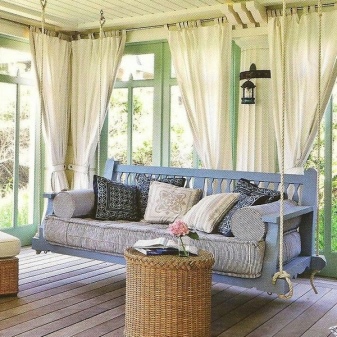
Views
The terrace can decorate any building, organically continuing it. The abundance of views makes it possible to choose an extension that is ideal for an existing home.
But the best option is the terraces laid down in the building project and erected along with it.
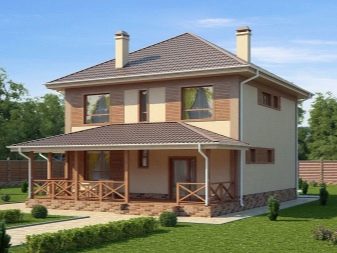

The annexes can be divided by location, shape, roof, fence.
- By location. Terraces can be belonging to the house, detached from the building, on the second floor level, or in two levels at once. In any case, it is better to place them where they receive a lot of sunlight and will not interfere with other buildings on the site.
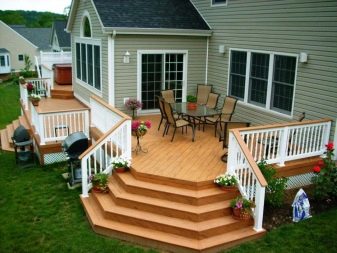
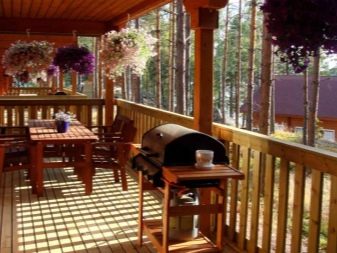

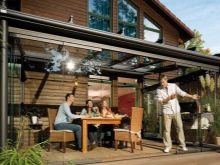
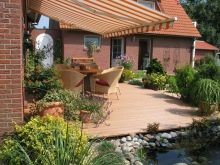
- By form. The flooring can look very different: square, rectangular, going around the house in a circle, their shapes can be broken and rounded. Roofs usually follow the geometry of the deck, but some of them only cover part of the extension.

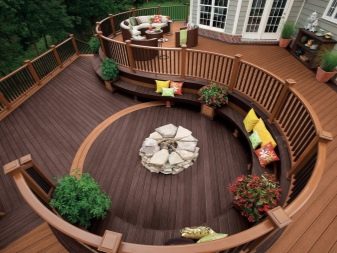
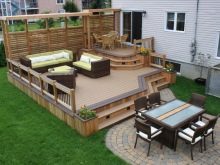
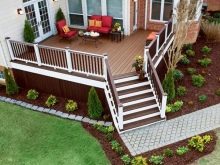
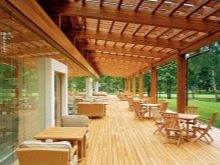
- Terraces are divided into indoor and outdoor. Warm, glazed and fully covered is a veranda, a terrace is considered closed if it has a roof and a wall near the house. An open annex is a plank flooring at the ground floor level, on hot days, umbrellas are installed on them to create shade. For regions with scorching sun or frequent rainfall, the roof should be a necessary addition to the extension.
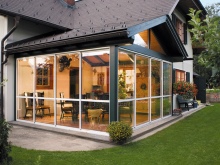
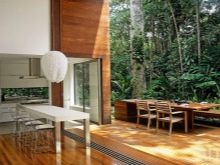
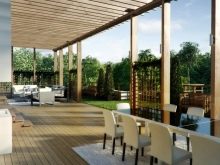
- Terraces are distinguished by a variety of fences, parapets, balustrades. Most often these are balusters made of wood, of various shapes. For upper floor terraces, it is safer to use solid parapets.
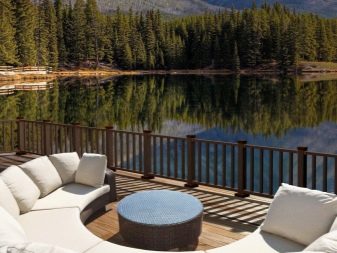
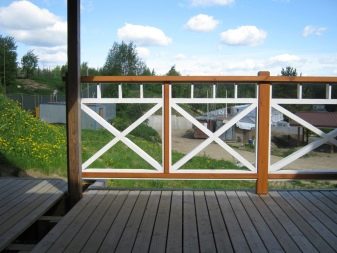

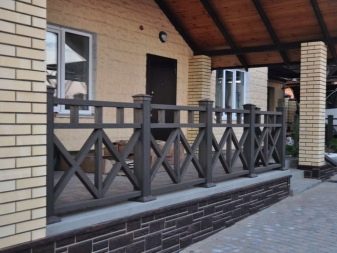
Project
The best terrace project would be a general plan with a country house under construction. Even if they are made on different foundations, the building will become a single architectural solution. To plan a covered terrace for a long-built building, a project should be drawn up and registered with the relevant organizations. Open flooring does not need registration, as it is considered a temporary building.
Before starting the project, you need to have a clear idea of the appearance of the terrace, the size and location where it will be located.
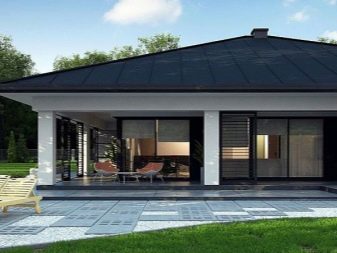

A place
At the initial stage, you should decide on the size of the structure. A huge extension against the background of a small house or a small terrace at the foot of a massive building will look strange.
Then the best place is chosen from many possible ones.
- The easiest option is at the entrance to the house. A comfortable terrace will become a seating area and replace the porch. It is easy to take out and bring in pillows for completing country furniture or trays with tea drinking devices.

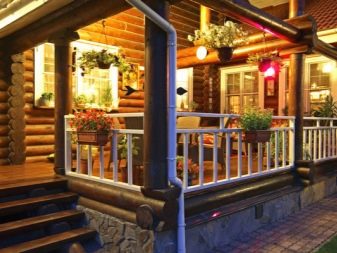
- The building can be located away from the house and be completely independent. If the terrace is equipped with a barbecue, barbecue or a summer fireplace, for safety reasons, it should be at least six meters away from the building, moreover, it should be on the leeward side of the house.
- The flooring is arranged around the building, completely encircling it around the perimeter.
- The terrace can be located on the second floor level. To such an extension, in addition to the aesthetic appearance, safety requirements are imposed. The fence should be high in the form of a parapet or often located balusters.
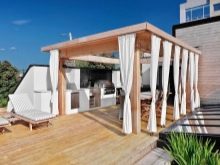
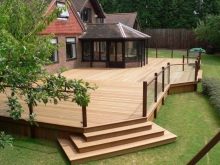
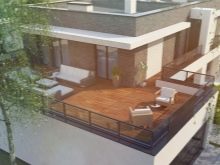
- Sometimes the structure is multi-level and is located at several floors of the building at once. They are usually united by a wide, reliable staircase.
- The extension is not always tied to the front door. It can be placed against the wall of the hall or kitchen, providing an additional exit to the terrace. Or hide from prying eyes from the inner side of the yard.
- The building can be located at once at several walls of the building (corner), so it is easier to divide it into zones, for example, a summer dining room and a resting place with a sofa and a swing.
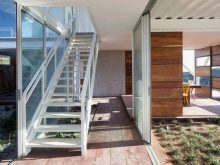
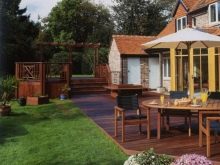
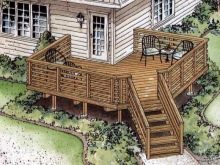
- Having erected the flooring, they take into account climatic conditions, for example, a wind rose, so that the structure is not in a draft. In the northern regions, terraces are built on the south side so that the sun illuminates them for a long time. For sultry areas, it is wiser to build an extension to the east or north, perhaps under the canopy of trees.
- Some buildings have a veranda and a terrace at the same time. An open deck is located at the entrance to a closed annex.
- The terrace can be placed by the pool or on a high hill to view the beautiful garden area.
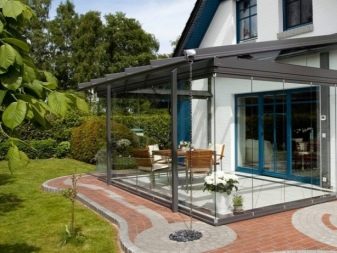
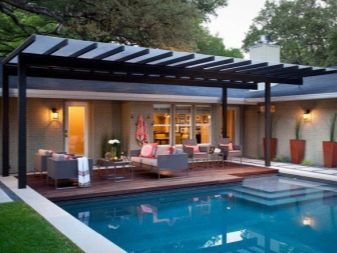
Shape and size
Having dealt with the place of construction, you should choose the optimal design.It must be practical and appropriate for the design of the building and landscape.
The size of the extension depends on the capabilities of the site, functional needs and aesthetics.
No matter how much you want to build flooring on a half-plot, it should be in harmony with the house, and not overwhelm it with its scale.


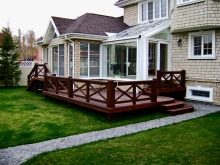
For minimal requirements, when it is difficult to distinguish between a terrace and a porch, a few meters are sufficient to provide a couple of chairs for outdoor seating. If the extension contains a table and chairs, its dimensions will grow to four square meters. You will need a swing, a sofa and other furniture - the flooring will have to be increased again.

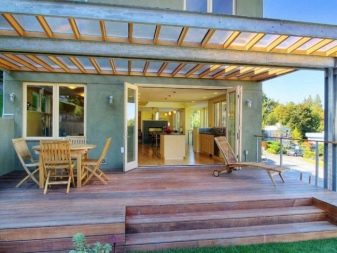
The shape of the terrace is dictated by the architecture of the house. If the entrance to the building is located in the center, a symmetrical semicircular flooring looks beautiful. An offset home door looks good with a rectangular or corner deck. The square extension is suitable for a center or structure on several levels. If the terrace is covered, the roof follows the shape of the deck, but sometimes it can cover only part of it.
Extensions have complex broken lines or combine several geometric shapes. It is better to entrust such a design to a specialist so that it does not look ridiculous.
The shape and appearance of the building is influenced by the staircase and railing.
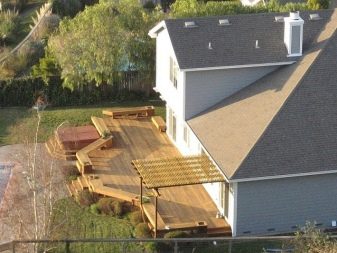
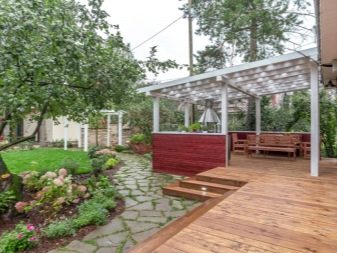
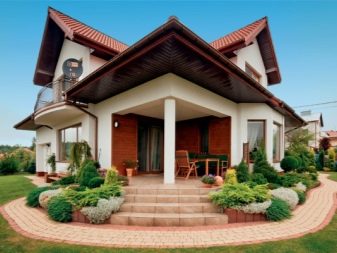

Plan and drawings
When the owner of the house has decided where he will build the terrace, what it is for and how it will look, the moment comes to draw up a project. If you are planning a grandiose construction, it is better to contact an architectural bureau for professional design. A small, single-level flooring can be planned independently.

A detailed design drawing is drawn up. In addition, a site plan is required with all buildings and the location of the terrace indicated on it.
The project includes:
- calculation of the dimensions of the structure;
- types of building materials;
- estimated weight of the structure;
- the type of foundation, combining it with the house;
- groundwater occurrence and soil structure;
- taking into account climatic conditions;
- roof design;
- stair sketches;
- a project for the construction of a stove or fireplace;
- types of lighting, they can be on poles or frame polterraces;
- an estimate is drawn up with a list of estimated costs.

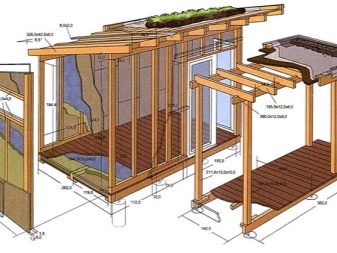
If the project is difficult to master yourself, you can contact the design office. It may be necessary to agree with the fire safety authorities, the sanitary station and the administration. Changes will be made to the documentation of the house. With an impressive terrace, it is better to draw up the documents correctly so that in the future there are no problems with the sale or donation.
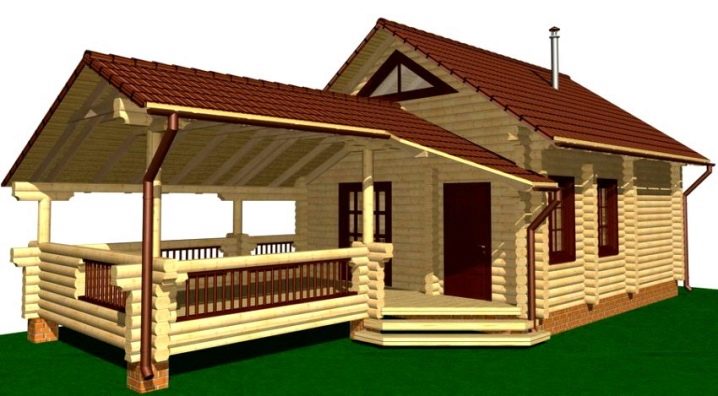
Materials (edit)
The material for the construction of the terrace is chosen taking into account compatibility with the main building and the general landscape design. A wooden flooring with brick columns under the roof is suitable for a brick house. If forging or stone is present in the decoration of the building and garden structures, the same materials should be used for the construction of the terrace. For a house made of logs or timber, an extension made of wood is suitable.
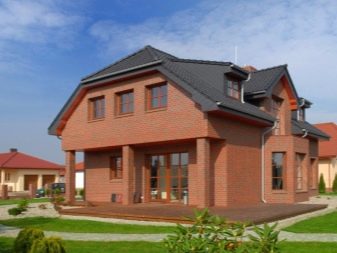
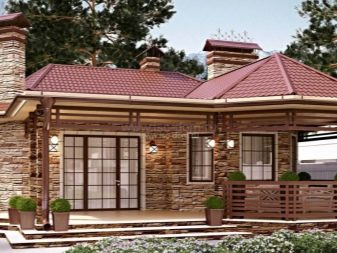

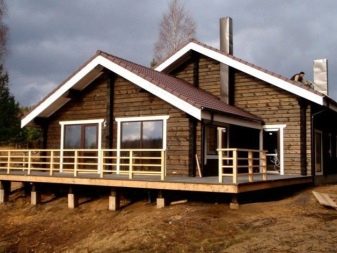
Different materials are used to create terraces.
- The flooring is made of a special board or timber, it is installed on piles. It can have gender.
- The floor is made of wood, laminate, clinker tiles, stone, rubber or concrete.
- The columns are built of brick, stone, wood or metal.
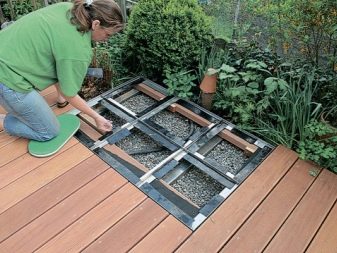

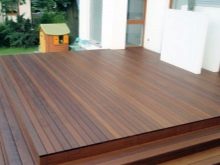
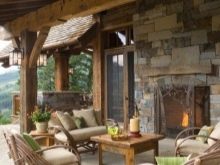
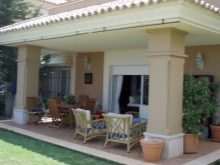
- Fences are built of wood, concrete, plaster, brick and metal.
- Ladders are made of the same materials as fences: wood, concrete, metal, brick. For two-level terraces, the best option would be to use metal spiral staircases.
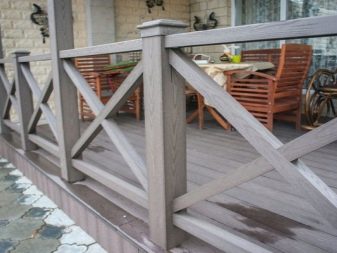
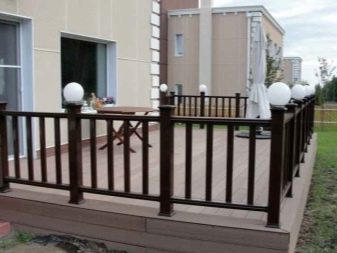
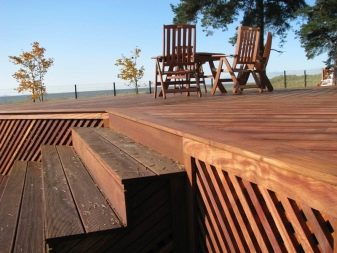
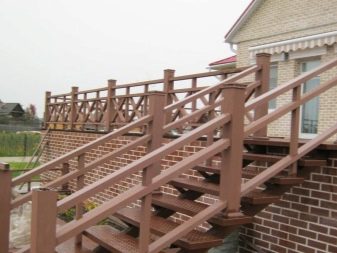
- The roof is covered with one material with a common roof, but you can choose lighter options. Plywood is laid under the soft coating along the frame profile. The glass construction is suitable for all buildings and styles.In favor of such a roof, we can say that it lets in a lot of light, is airy, graceful and comes in harmony with the external environment. An alternative to glass is the use of polycarbonate. On one side it is attached to the adjoining wall of the house, and on the other - to the prepared supports.
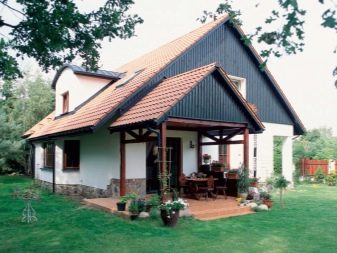
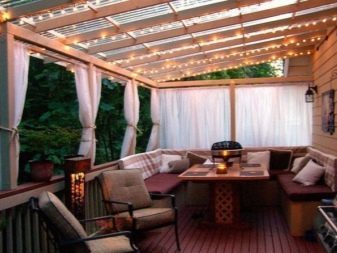

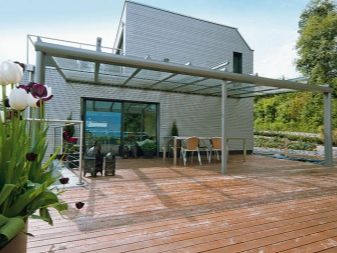
- For the construction of terraces, a modern inexpensive material wood-polymer composite (WPC), reminiscent of wood, is used.
- Forging can be used for finishing as an elegant decoration.
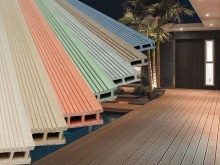
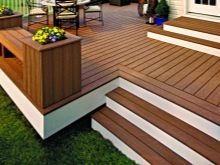

Design
When the project has been created and legalized, a place has been found, materials have been selected, the design of the structure has been developed - it is time to build a terrace.

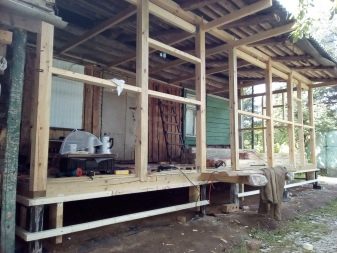
Construction
At the initial stage, the foundation is laid. The terrace is open and closed (it has a roof), it is made of various building materials, therefore it has a different weight. For heavy buildings, a strip foundation is suitable, it is poured along the perimeter of the structure and brings it to the same level with the first floor of the building.
For a columnar base, it is not necessary to dig trenches, it is enough to dig holes to the level of freezing of the soil and cement the supports in them. The pillars are not connected to each other, they are exposed at the corners of the structure and support the frame. The closer the groundwater is to the surface, the deeper the supports will have to be lowered into the ground.
Columnar foundations are suitable for light buildings.
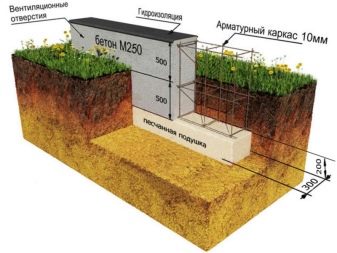

If the terrain is uneven, with problem soils, close adherence of groundwater, you will need a pile-screw foundation. The blades are welded onto the supports and screwed into the ground with effort. This is a solid and reliable foundation, it is used for the construction of piers, it holds the building on any dubious soil.
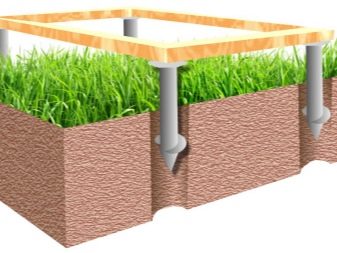

When the foundation has been removed, it is time to lay the flooring. Logs are mounted on the prepared base, which are fastened with screws, the location of the beams is marked. Having connected the logs and beams with corners, the flooring is laid on top. The edges of the boards are leveled with a circular saw or jigsaw. For the passage of air and the outflow of rainwater, the floorboards are not adjusted too close, there must be a space of several millimeters between them.
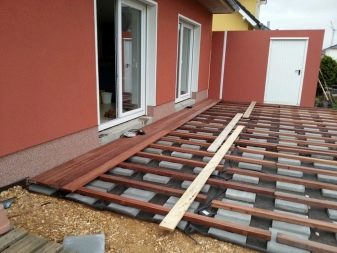

For the terrace, according to the project of which the roof was planned, vertical beams are exposed. The length and strength of the beams depends on the weight of the roof and the height of the structure. The roof should protrude half a meter wider than the deck so that precipitation does not flood the floor. Roofs can have different shapes: flat, straight, single or gable.
If you follow the sequence of actions without violating the technology, you can build the extension yourself.
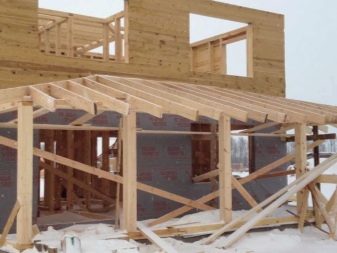
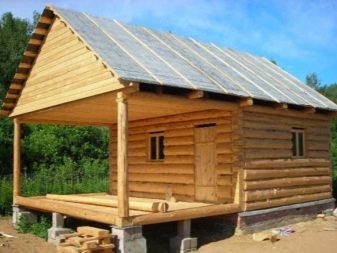
Registration
Having built the terrace, you should proceed to the last part of the design project - the design of the structure. For many, it is a place of rest, therefore it must look beautiful and cozy. And no matter where the terrace is located, in a private estate or near a summer cottage, its arrangement reflects the owner's taste and creates conditions for a comfortable stay.
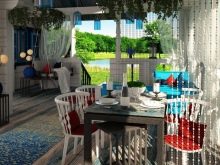

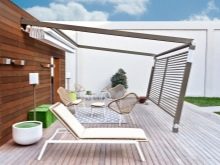
Even an open summer building can have its own style and beautiful interior. To create it, a large selection of garden furniture is offered in specialized markets. It is not difficult to arrange the resting place ourselves, the landscape can suggest ideas. If the terrace is located in an open space, does not have a roof, and there are no shady trees around, it is enough to put up stylish umbrellas. There are other options: use canopies over the sofa or a removable awning fixed on metal racks.

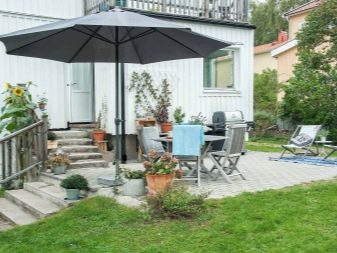
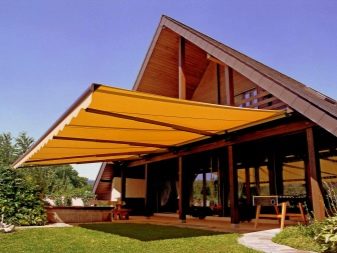
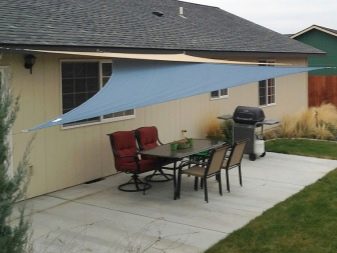
Terraces can be designed in various interior styles, for example, using brickwork at home to create a loft style. A railing with carved balusters will accentuate the romantic style, while forged elements will help create gothic accents. Any style can be easily played up with the help of versatile lighting and thoughtful landscaping.

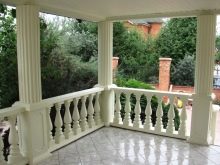
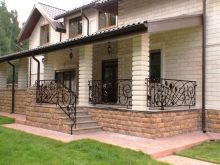
Tips & Tricks
For the construction and arrangement of a terrace, many nuances should be taken into account.
- If you don't want to deal with paperwork or worry about design, open flooring will be the best solution to these problems, it will be inexpensive.
- It does not matter for the terrace floor whether it is warm or not, but the strength of the coating and the activity of using the extension should be taken into account.
- On a small terrace, you can allocate a place for rest and eating, and build a fireplace or stove as a free-standing structure. You should pay attention to the wind rose of the area so that the smoke does not go towards the terrace.
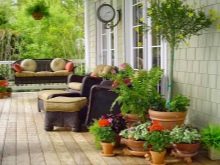
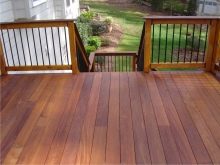
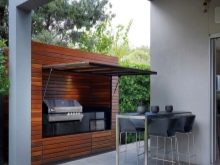
- When building a foundation, it is necessary to leave a gap of 4-5 cm between it and the base of the house. When shrinking, the structure can "play", and a heavy building will pull a light extension.
- When erecting an open terrace, you should take into account the shadow from the wall of the building. For southern latitudes, it will become a salvation; instead of a roof, you only need an umbrella from the sun.
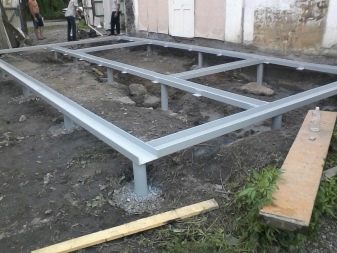

- When choosing supports for the roof, not only the cost of the material is important, but also the calculation of the weight of the roof, which it will have to hold, as well as the possibility of replacing the elements in case of damage.
- For a very small area, the optimal width of the extension can be twenty meters: this is enough for two adults to miss each other. If you make it a little wider, you can hang a flowerpot with flowers and put a chair, you get a cozy little terrace.
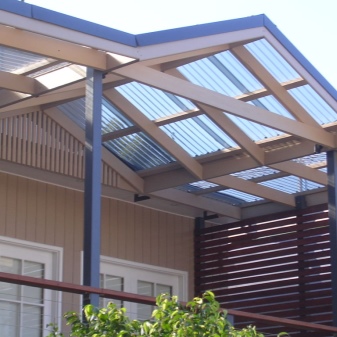
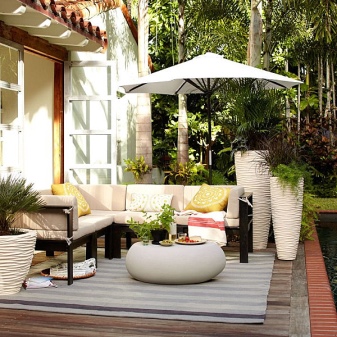
Beautiful examples
Even the simplest terraces look attractive, and if a designer has worked on their project, they will become a favorite vacation spot for the whole family.
- a small house with two cozy terraces - a practical continuation of the building;
- open multi-stage annex with a seating area;
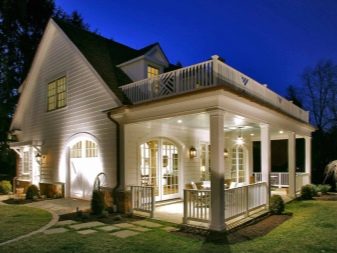
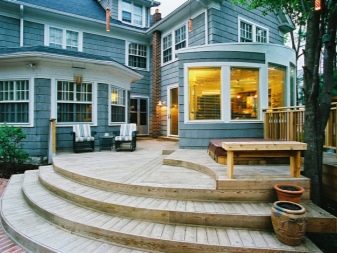
- covered terrace in Mediterranean style;
- sun umbrellas are often used on open decks;
- complex construction of an open terrace, talentedly implemented by the designer.
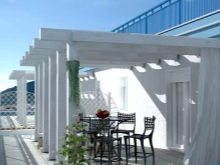
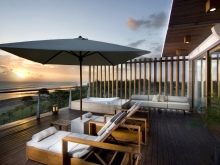
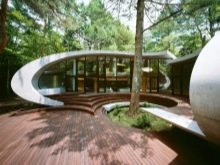
Having created a beautiful project and investing in it, you can get a functional continuation of the house, its real decoration.
For information on how to build a terrace, see the next video.





























































The comment was sent successfully.